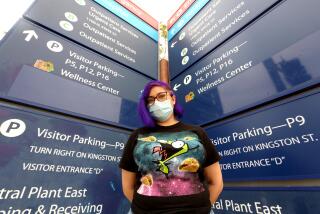Medical Center ‘Saturated’ Since Trauma Unit Closed
- Share via
IRVINE — Nurses are threatening to quit, surgeons are “up in arms” and the emergency room at UCI Medical Center has been “saturated” day after day, in part because one of Orange County’s four trauma centers closed last year, UCI Medical Center director Mary Piccione told a meeting of health care experts Friday.
Piccione warned that Orange County officials must quickly recruit another hospital to operate a fourth trauma center and share the burden of the county’s critically injured patients because her hospital cannot operate under siege conditions indefinitely.
“We cannot continue at the level we’re working at,” Piccione told two dozen health care experts who comprise the Orange County Coalition for Health Care Solutions, a task force organized by state Sen. Marian Bergeson (R-Newport Beach).
Piccione’s comments followed a report by county Emergency Medical Services officials that suggested there have been few problems in the trauma system since Dec. 27, when Fountain Valley Regional Hospital and Medical Center closed its trauma center for good.
At the time, many health care advocates said the closure sounded the death knell for Orange County’s nationally known emergency care system. They predicted that the three remaining hospitals--UCIMC in Orange, Western Medical Center-Santa Ana and Mission Hospital Regional Medical Center in Mission Viejo--would not be able to care for all of the county’s accident and gunshot victims. And, warned Dr. John West, the surgeon who helped found the trauma network in 1980, many more trauma patients would die because of longer ambulance or helicopter rides.
County officials initially suggested that the system would survive fine without Fountain Valley, which had cited too many indigent patients and an inability to recruit neurosurgeons as the reasons it closed down its trauma center. But lately, officials have been negotiating with Los Alamitos Medical Center, trying to persuade it to join the trauma system and fill the gap left by Fountain Valley.
“We’re going to exert every effort we can to get a fourth trauma center,” Ron DiLuigi, assistant director of the Orange County Health Care Agency, said Friday.
Meanwhile, county EMS manager Betty O’Rourke and EMS medical director Robert Bade released a report showing that longer paramedic runs--lasting more than 20 minutes--were occurring no more frequently than last year before Fountain Valley closed its trauma center.
The report did note that the UCIMC and Western Medical Center-Santa Ana have taken most of the patients that would have otherwise gone to Fountain Valley--in all 95 patients were sent to UCI this January and 92 to West-Med. The report also said that those two hospitals were closed to trauma cases because they were full 41 times this January, compared to 23 times in January, 1989.
In brief comments to Bergeson’s task force, O’Rourke said many of the closures occurred because both hospitals’ intensive care units were full, but she said this situation “has not had an adverse effect” on the hospital’s trauma departments.
Piccione disagreed. The EMS figures “don’t reflect the full picture” of a hospital, she argued. In January, for instance, UCI handled not 95 trauma cases but 123, she said. The additional cases involved neurological injuries, Piccione said, but “they’re trauma cases and they have to be done.”
She added that UCI’s operating rooms were so filled with trauma cases lately that many elective cardiac surgeries were canceled and “our surgeons are up in arms.”
Officials at Western Medical Center-Santa Ana did not attend Friday’s meeting, but Dr. Rand Hardy, trauma center director there, said in a brief interview, “We’re seeing some of the same problems” as UCI. “Our intensive care unit has been filled and we had to open up some additional ICU beds to handle the traumas coming in. It has placed some strain on the hospital.”
Hardy said his statistics showed that trauma cases since Fountain Valley closed are running 30% above last year. “Our physicians are coping with the increase,” although the nursing staff was a little “thin” and some surgeons were unhappy that their elective cases have been bumped, he said.
More to Read
Sign up for Essential California
The most important California stories and recommendations in your inbox every morning.
You may occasionally receive promotional content from the Los Angeles Times.













